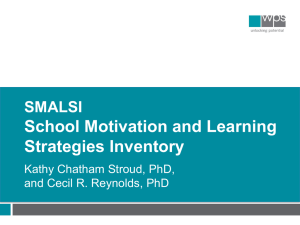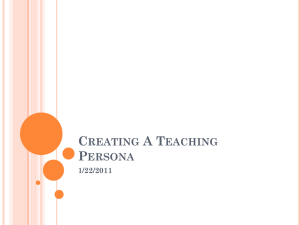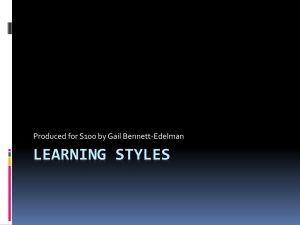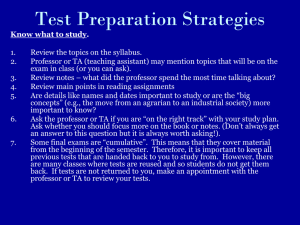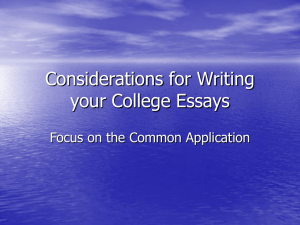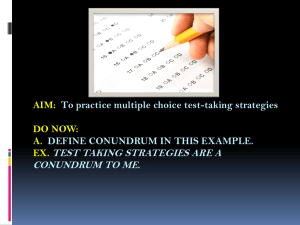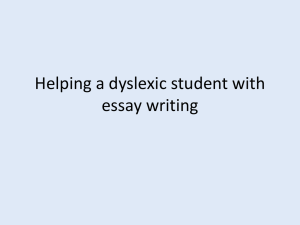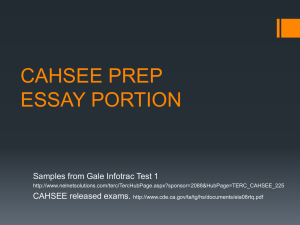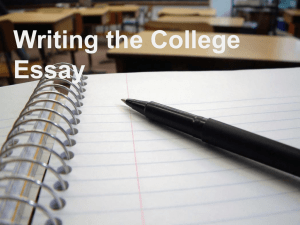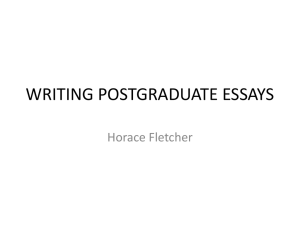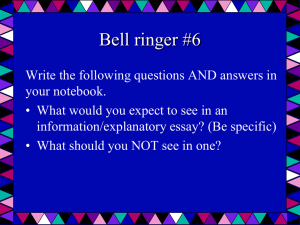Test-Taking Goals
advertisement
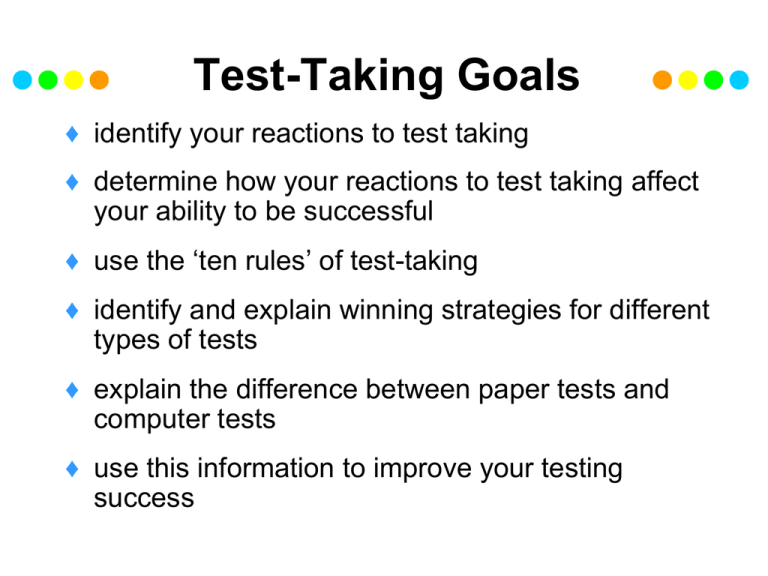
Test-Taking Goals ♦ identify your reactions to test taking ♦ determine how your reactions to test taking affect your ability to be successful ♦ use the ‘ten rules’ of test-taking ♦ identify and explain winning strategies for different types of tests ♦ explain the difference between paper tests and computer tests ♦ use this information to improve your testing success Testing Self Check Y = y e s ; fre q u e n tly S = s o m e tim e s N = no; never 1 . I kn o w th a t a lo w te s t g ra d e d o e s n o t m a ke m e a fa ilu re . Y S N 2 . I re a lize th a t is it o ka y n o t to k n o w e ve ryth in g o n a te s t. Y S N 3 . I fo llo w b o th w ritte n a n d o ra l te st d ire c tio n s c a re fu lly. Y S N 4 . B e fo re I b e g in a te st, I p re -vie w it b y lo o k in g fo r th e p o in t va lu e s . Y S N 5 . W h e n p re vie w in g m y te s ts , I lo o k fo r a n s w e rs to o th e r q u e s tio n s . Y S N 6 . I b u d g e t m y tim e e ffe c tive ly w h e n I ta k e a te s t. Y S N Y S N 8 . I a m a w a re o f th e d iffe re n ce s b e tw e e n c o m p u te r-b a se d a n d p a p e r te s ts . Y S N 9 . I re vie w re tu rn e d te s ts fo r to p ic s I n e e d to u n d e rs ta n d b e tte r. Y S N 1 0 . I le a rn fro m m y te s tin g m is ta k e s . Y S N 7 . O n p a p e r te s ts , I d o th e e a s ie st q u e s tio n s firs t a n d co m e b a c k la te r to th e h a rd e r o n e s . R a te Y o u rs e lf: N u m b e r o f Y ’s _____ x 100 = _____ N u m b e r o f S ’s _____ x 50 = _____ N u m b e r o f N ’s _____ x 0 = _____ Stress, Tests, and You ♦ How does test taking affect you? ♦ calm and relaxed ♦ tense and uptight ♦ How does your body react? ♦ muscles tighten ♦ appetite disappear ♦ overeat ♦ Do your sleeping habits change? ♦ Is your breathing steady? ♦ yawn a lot before a test Good Stress ♦ helps you perform better ♦ even when you feel anxious or scared ♦ gets your adrenaline flowing ♦ can sharpen your awareness ♦ keeps you alert ♦ helps you become motivated ♦ energizes your body Bad Stress ♦ makes performing or achieving your goals challenging ♦ may be linked to increased health problems ♦ depression ♦ heart disease ♦ cancer ♦ demotivates you ♦ zaps your energy ♦ is a symptom of test anxiety ♦ can prevent you from doing your best on exams Stress Reactions S tress R eactio n s to Tests B efo re, D u rin g , o r A fter _____ I feel nervous. _____ _____ _____ _____ I feel excited. _____ _____ _____ _____ I feel relieved . _____ _____ _____ _____ I feel optim istic and m ak e positive com m ents. _____ _____ _____ _____ _____ _____ _____ I usually g et a headache. _____ _____ _____ _____ M y neck , back, or shoulders ache. _____ _____ _____ _____ I usually feel pretty g ood. _____ _____ _____ _____ M y breathing is rapid and shallow . _____ _____ _____ _____ I feel pessim istic and m ak e neg ative. com m ents Stress Reactions cont’d _ _ _ _ _ M y b re a th in g is re la xe d a n d d e e p . _____ _____ _____ _ _ _ _ _ M y h e a rt p o u n d s, a n d m y p a lm s sw e a t. _____ _____ _____ _ _ _ _ _ I lo se m y a p p e tite . _____ _____ _____ _ _ _ _ _ I p a n ic. _____ _____ _____ _ _ _ _ _ I h a ve tro u b le sle e p in g . _____ _____ _____ _ _ _ _ _ M y m in d g o e s b la n k. _____ _____ _____ _ _ _ _ _ I’m a fra id I w o n ’t h a ve e n o u g h tim e to fin ish . _____ _____ _____ _ _ _ _ _ I w o rry th a t I’ve stu d ie d th e w ro n g th in g s. _____ _____ _____ _ _ _ _ _ I w o rry th a t I h a ve d o n e p o o rly. _____ _____ _____ _ _ _ _ _ I a m co n fid e n t in m y a b ility to d o w e ll. _____ _____ _____ _ _ _ _ _ I a m a fra id I d o n ’t kn o w e ve ryth in g . _____ _____ _____ _ _ _ _ _ I fe e l stu p id . _____ _____ _____ _____ ____________________________ _____ _____ _____ Letting Go of Anxiety ♦ Dealing with Feelings ♦ breathe ♦ scan your body ♦ tense and relax ♦ use guided imagery ♦ describe it ♦ exercise aerobically ♦ get help Letting Go of Anxiety ♦ Dealing with Thoughts ♦ mentally yell ‘STOP’ ♦ daydream ♦ visualize success ♦ focus ♦ praise yourself ♦ consider the worst Ten Rules of Test-Taking Rule 1: Act as if you will succeed. ♦ thought is powerful ♦ negative thoughts raise stress levels ♦ confidence may drop ♦ leads to feelings of failure ♦ think about success ♦ smile ♦ take deep, slow breaths ♦ close your eyes ♦ imagine getting test back with a good grade written at the top ♦ learn more about visualization and positive self-talk Ten Rules of Test-Taking Rule 2: Arrive ahead of time. ♦ being on time sets your mind at ease ♦ have a better chance of getting your favorite seat ♦ let go of your anxiety ♦ spend time relaxing and preparing yourself for the game ahead Ten Rules of Test-Taking Rule 3: Bring the essential testing tools. ♦ extra pens, sharpened pencils, erasers, a calculator, dictionary, other needed items ♦ if open-book: ♦ notes – create your own index ♦ textbook – plan on using text’s index ♦ Post-It© notes placed at important spots ♦ flashcards you have made ♦ other study tools you have made Ten Rules of Test-Taking Rule 4: Ignore panic pushers. ♦ people who ask you questions about the material to be tested on ♦ people who ask about how much or long you studied ♦ if you know the answers ♦ you will be confident ♦ if you do not know the answers ♦ you may panic and lose your confidence ♦ spend your time concentrating on what you know, not what you don’t know Ten Rules of Test-Taking Rule 5: Pre-view the playing field. ♦ listen to instructions ♦ read directions slowly and carefully ♦ clarify anything you do not understand ♦ determine the point spread ♦ decide how much time you can spend on each question and still finish the test on time ♦ know the point value; ask if necessary ♦ look for easier and more challenging sections ♦ do these first Rule 5 continued ♦ budget your time ♦ look at point value of a section not the number of questions ♦ stick to your time limits on sections ♦ budget time to look over the test at end ♦ use the test as an information tool ♦ look for clues that answer other questions ♦ use terminology from objective questions for essays Ten Rules of Test-Taking Rule 6: Write in the margin. ♦ before you begin the test; do a memory dump; write down: ♦ key terms ♦ names ♦ dates ♦ memory aids ♦ formulas ♦ any information you’ll need and might forget ♦ do an outline or mind map before starting each essay question Ten Rules of Test-Taking Rule 7: Complete the easiest, shortest questions first. ♦ helps build your experience of success ♦ stimulates associations and prepares you for more difficult questions ♦ mark tough questions so you can come back later ♦ avoid spending too much time on a challenging question ♦ might run out of time to answer the questions you do know ♦ if you are stuck, move on Ten Rules of Test-Taking Rule 8: Know if there is a guessing penalty. ♦ no penalty and time is running out ♦ take a wild guess (true or ‘c’) ♦ there is a penalty ♦ choose your answers wisely ♦ leave blank the answers you do not know ♦ unsure about guessing penalties ♦ ask your instructor Ten Rules of Test-Taking Rule 9: Avoid changing answers. ♦ research has shown that three out of four times your first choice is usually correct ♦ if you think your first answer is wrong because you misread the question ♦ do change your answer ♦ avoid changing answers unless you are absolutely sure your answer is wrong Ten Rules of Test-Taking Rule 10: Write clearly and neatly. ♦ easy to read ♦ look presentable ♦ answers in the right places ♦ easier it is for the instructor to read ♦ better your chances of getting a higher grade True-False Questions ♦ read directions carefully ♦ usually easier as you have only two choices ♦ read the whole statement carefully ♦ one word can make a statement inaccurate ♦ look for absolute or limiting words ♦ examples: always, every, all, no, never, none, only, entirely, guaranteed, great, much, etc. ♦ leave little room for exceptions ♦ sentences containing these words would seldom be true True-False Questions ♦ look for tentative words. ♦ examples: seldom, sometimes, some, often, most, many, few, usually, generally, frequently, ordinarily, etc. ♦ provide room for exceptions ♦ sentences containing these words would usually be true ♦ long true-false statement ♦ more likely is true True-False Questions ♦ any part of it is false ♦ whole statement is false ♦ watch for negative words and prefixes ♦ examples: not, never, none, no, except, etc. and il-, im-, ir-, dis-, un-, non-, a-, etc. ♦ circle or underline these negatives ♦ do not disregard them ♦ consider omitting the word ♦ decide the answer without the negative ♦ put the word back in ♦ reverse the answer Sample True-False Test _ _ _ _ _ _ 1 . A ll p e o p le h a ve sim ila r w a ys o f le a rn in g . ______ 2. M e n a re u su a lly p h ysica lly stro n g e r th a n w o m e n . _ _ _ _ _ _ 3 . R o te m e m o riza tio n is th e m o st e fficie n t w a y to le a rn . _ _ _ _ _ _ 4 . S o m e stu d e n ts stu d y a lo t, b u t n o o n e stu d ie s a s m u ch a s th e y sh o u ld . _ _ _ _ _ _ 5 . T h e w a y to le a rn th e m o st e ffe ctive ly is n o t to g ive in to d istra ctio n s. _ _ _ _ _ _ 6 . S o m e b ird s d o n o t fly. _ _ _ _ _ _ 7 . C o lle g e is a lw a ys h a rd e r th a n h ig h sch o o l. _ _ _ _ _ _ 8 . F o r a jo b in te rvie w , yo u m u st w e a r cle a n , n e a tly p re sse d clo th e s a n d lo o k p re se n ta b le . _ _ _ _ _ _ 9 . S m a rt stu d e n ts a lw a ys stu d y tw o to th re e h o u rs e a ch d a y fo r e ve ry c la ss. _ _ _ _ _ _ 1 0 . F re q u e n tly, stu d e n ts le a ve to o m u ch stu d yin g to d o u n til fin a ls w e e k. Multiple-Choice Questions ♦ read directions carefully ♦ how many correct answers are possible? ♦ are you looking for the correct answer(s) or the best answer or the worst answer? ♦ are you looking for similarities or opposites? ♦ do you need a singular or plural answer? ♦ clarify if you are not sure Multiple-Choice Questions ♦ be wary of ‘all of the above’ or ‘none of the above’ responses especially if not used very often ♦ often are ‘fill’ answers ♦ answer each question in your head before you look at the possible answers ♦ read the question and each option separately ♦ make sure you consider all options ♦ consider each as a true or false statement ♦ mark it to the side accordingly Multiple-Choice Questions ♦ be suspicious of negatives and absolutes ♦ circle or underline these to make sure you are aware of them ♦ answer negatives positively first, then the exception will stand out ♦ carefully consider similar options, opposite answers, more general or more inclusive options ♦ learn how to make educated guesses Sample Multiple-Choice Test ______ 1. B ears can be found w andering a) in the w oods. b) in parks. c) in fields. d) in the m ountains. e) all of the above ______ 2. S tudents freq uently succeed in test taking because a) all tests are easy. c) they alw a ys do their assig nm ents on tim e. b) they are usually prepared. d) they alw a ys try hard. ______ 3. M ig raine headaches are m ost com m only caused by a) allerg ic reactions to food. c) allerg ic reactions to m edicine. b) lack of sleep. d) heredity. ______ 4. T he reasons m ost students g ive for failing tests include a) studying the w rong inform ation. c) not having enoug h tim e to study. b) cram m ing and being unprepared. d) being g iven unfair tests. ______ 5. A ll of the follow ing are ing redients of student success except a) taking g ood notes. c) learning from m istakes. b) studying ahead of tim e. d) cram m ing for exam s. Sample Multiple-Choice Test ______ 6. ______ 7. S tudents g o to class because a) since it is necessary. b) inform ation is being taug ht. c) it is the m ost fun w ay to spend the day. d) the law of xfg hot recom m ends it. W hich statem ent(s) is (are) not correct? a) S tudents often study in the library. b) S tudents do not study enoug h. c) M ost students should try to study m ore. d) A ll professors should g ive essay tests. ______ 8. C olleg es often a) g et torn dow n. b) try to educate students in the w orst possible m anner w ith the g reatest am ount of expense. c) chang e their nam es. d) try to educate students in the best possible m anner w ith the least am ount of expense. ______ 9. T he distance from P aris to N ew Y ork is approxim ately a) 3000 – 4000 m iles. c) 9000 – 10,000 m iles b) 10 – 20 kilom eters d) 500 – 100 m iles Scantron Tests ♦ make sure the answer you mark corresponds to the question you are answering ♦ check the test booklet against the answer sheet whenever: ♦ you switch sections ♦ come to the top of a column ♦ if you skip a question ♦ make sure you are marking the correct answer spot ♦ watch for stray marks ♦ can be ‘read’ as answers ♦ use the right kind of pencil Matching Questions ♦ when used ♦ usually only a part of a test ♦ similar to multiple choice ♦ only the correct response needs to be identified ♦ more challenging ♦ must locate the matching terms or ideas from a list Matching Questions ♦ read directions carefully ♦ ask questions if necessary ♦ can options be used more than once? ♦ are you looking for similar or opposite terms or ideas? ♦ count number of choices in each column ♦ if not equal – work from longer column to shorter column Matching Questions ♦ consider each option each time ♦ systematically eliminate distracters ♦ answer the easiest ones first ♦ where possible, cross off the used ones ♦ consider grammatical clues ♦ match up nouns, adjectives, events, dates ♦ mentally repeat the choices ♦ helps you to focus Sample Matching Test ______ 1. A c tive L e a rn in g A . L iste n in g fo r in s tru c to r c lu e s ______ 2. B a c k g ro u n d k n o w le d g e B . G e ttin g a n o ve rvie w o f a c h a p te r ______ 3. C ritic a l T h in k in g C . W h a t yo u a lre a d y k n o w ______ 4. P re vie w in g D . Id e a lis tic , b u t im p ra c tic a l ______ 5. P a s s ive L e a rn in g E . U s e d fo r e ffic ie n t stu d yin g a n d livin g ______ 6. M in d W a n d e rin g F . L o o k o ve r o r vie w g e n e ra lly ______ 7. L e a rn in g In flu e n c e s G . S o m e th in g s th a t a ffe c t yo u r c o n c e n tra tio n ______ 8. S k im m in g a n d s c a n n in g H . L e a rn in g lik e a ro ck ______ 9. T im e M a n a g e m e n t I. L e a rn in g lik e a s p o n g e ______ 10. S u rve y J . H ig h o r fa st re a d in g g e a rs . ______ 11. T e st-T a k in g K . N o te -ta k in g m e th o d ______ 12. Q u ixo tic L . U s e d fo r e va lu a tio n M . C a n o n ly b e re d u c e d n o t e lim in a te d N . T h in k in g a b o u t th in k in g Fill-in-the-Blank Questions ♦ usually are only a part of a test ♦ more difficult than multiple-choice, matching or true-false sections ♦ leave this part until the last ♦ look for the answer in other questions ♦ use memory techniques when stuck ♦ reword the question so that the blank is at the end, if possible Fill-in-the-Blank Questions ♦ watch for grammatical clues ♦ is the verb singular or plural? ♦ does the word “a” or “an” appear before the blank? ♦ your answer must make sense in the context in which it is written ♦ consider the length of the blank; usually: ♦ a short blank means a short answer ♦ a long blank means a long answer ♦ two blanks means a two-word answer Sample Fill-in-theBlank Test 1. _ _ __ _ __ _ __ __ _ __ _ ___ _ __ _ __ _ __ __ _ is th e p ro ce ss fo r b e co m in g a citize n . 2. T he la rge st an im a l in th e w o rld is a __ _ __ _ __ _ __ _ __ _ __ __ _ __ _ __. 3. _ _ __ _ __ _ _ _ __ __ _ ___ _ _ _ _ __ __ _ __ __ _ is th e co lle ctive n a m e of S u p e rio r, H u ro n , E rie , O n ta rio , a nd M ich iga n . 4. _ _ __ _ __ _ __ __ _ __ _ ___ _ m e an s pu ttin g off do in g so m e th in g un p leasa n t o r b u rde n som e un til a fu tu re tim e . 5. A ll re a d e rs sh o u ld le a rn to rea d fa ste r b e ca u se it in cre a se s th e ir _ ___ _ __ _ __ _ __ __ _ __ _ ___ . 6. T he be st w a y to b u ild vo ca bu la ry is to u se yo ur _ _ _ __ __ _ __ _ __ _ _ __ _ __ _ __ _ __ __ _ __ _ ___ . 7 A n __ _ __ __ _ __ _ _ le a rn e r is o ne w h o ta ke s re sp on sib ility fo r h is o r h e r le a rn in g an d le a rn s from m ista ke s. 8. L io n s a re m o st like ly to b e fo un d in _ __ _ __ ___ _ __ _ __ _ __ __ _ . Short Answer Questions ♦ think before you write ♦ generally requires an answer of only a few sentences ♦ look for key words ♦ learn these definitions ♦ start off by restating the key words in your answer ♦ give direct, concise answers ♦ over-learning material really pays off ♦ when you are unsure of the answer: ♦ guess if there are no guessing penalties ♦ leave plenty of space between answers Essay Questions ♦ test directions are especially important ♦ how many essay questions do you need to answer? ♦ how long should the essay be? ♦ how should you budget your time? ♦ what type of answers should you give? ♦ use the list of key words ♦ how many components do you need to respond to within the question? Essay Questions ♦ write for the intended audience ♦ intended audience is your professor ♦ write as though the reader knows nothing about the topic ♦ write in essay form; this means: ♦ paragraphs ♦ topic sentences ♦ transition words between paragraphs ♦ complete sentences ♦ etc. Essay Questions ♦ organize your ideas before you begin writing ♦ think about how the ideas flow ♦ consider using an outline or mind map in the margin ♦ enables you to write faster ♦ less likely to leave out important facts ♦ if you don’t have time to finish: ♦ your outline could win you some points Essay Questions ♦ get to the point quickly ♦ forget introductions ♦ include part of the question in your answer ♦ when you expand your answer with supporting materials and facts, ♦ start out with the most solid points ♦ be accurate grammatically and with spelling ♦ consider using a pocket dictionary if allowed Essay Questions ♦ make your paper easy to read ♦ write neatly ♦ use an erasable pen ♦ write on the right-hand side of your test ♦ leave the left side for making changes and additions ♦ ♦ ♦ ♦ ♦ ♦ ♦ leave space between answers write on top side of paper only leave margins – side, top, and bottom name, date, and number every loose page summarize your answer first substitute synonyms for words you use frequently use connecting words to make the essay flow Essay Questions ♦ proofread your answers ♦ silently reread ♦ word for word ♦ pronounce every word in your head ♦ catch grammatical and spelling mistakes ♦ look at flow of ideas and organization Performance Tests ♦ different than written tests ♦ require a performance or demonstration ♦ preparation: ♦ study and understand the information you have to demonstrate ♦ practice until you are sure you can perform the required task well ♦ study, then practice, practice, practice Open-Book Tests ♦ prepare thoroughly for these ♦ usually more difficult ♦ when studying: ♦ write down any formulas you will need on a separate sheet ♦ place Post-It © notes or paper clips on important pages ♦ tables, flowcharts, etc. ♦ number notes and make a short table of contents Computer-Based Tests ♦ usually multiple choice ♦ score based on how well you answer and on the number of questions you answer ♦ usually a penalty for wrong answers ♦ testing time management is key ♦ complete on-line tutorials and sample questions before attempting test ♦ visit web site of the test maker for more information on the test Computer-Based Tests ♦ results are usually provided immediately ♦ before you finish you may have the opportunity to cancel the results before you see your score ♦ if you cancel: ♦ you will need to reschedule another testing date ♦ you will pay again ♦ if you see your score ♦ cannot cancel the test ♦ must accept the results Computer-Based Tests ♦ linear mode: ♦ questions are preset and given in numerical order ♦ can return to any question Computer-Based Tests ♦ computer- adaptive ♦ selects the difficulty of the next question based on your previous answer ♦ you must answer the question the first time you see it ♦ you cannot go back and change your answer Test-Taking ♦ taking a test is like playing a game ♦ object of the game is to get as many points as possible in the time you are given to play ♦ remember there is always another opportunity to play the game, or take a test ♦ you can use these strategies for every type of test you take ♦ may not work all the time ♦ works most of the time
